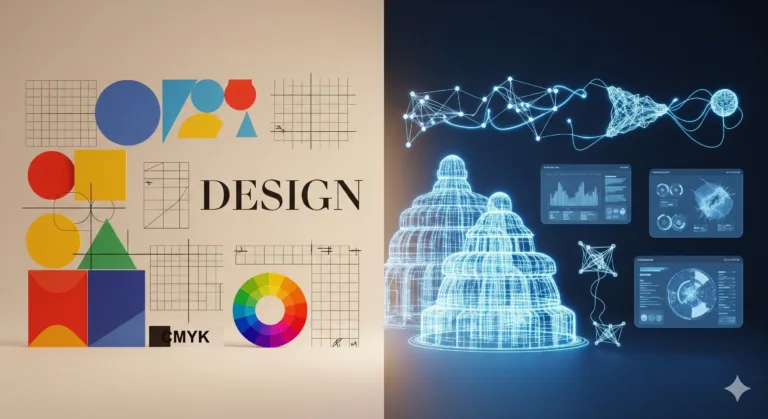Mastering Visual Composition for Clear, Impactful Designs
Have you ever looked at a design—be it a poster, a website, or a simple social media graphic—and felt that it just *works*? That everything is in its right place, guiding your eye effortlessly through the message? This isn’t accidental; it’s the result of masterful Visual Composition. For beginners in design, this concept might sound complex, but it’s fundamentally about arranging elements to create a clear, harmonious, and impactful visual story. It’s the art of bringing order to chaos, transforming individual pieces into a cohesive whole that resonates with your audience.
In our daily lives, we constantly interact with compositions, often without realizing it. From the way products are arranged on a supermarket shelf to the layout of a news article, effective visual arrangement is everywhere. When done well, it makes information easy to digest, calls to action obvious, and overall experiences pleasant. When done poorly, it can lead to confusion, frustration, and ultimately, a missed message. Understanding Visual Composition empowers you to make intentional choices that elevate your designs from merely existing to truly communicating with clarity and purpose. It’s a foundational skill that allows you to control how your audience perceives and interacts with your creative work, ensuring your message is not only seen but also understood and remembered. This principle is the silent architect behind every successful visual piece.
Table of Contents
What Exactly is Visual Composition?
At its core, Visual Composition is the arrangement of visual elements within a design space to create a harmonious and effective whole. Think of it as choreographing a dance for the viewer’s eye. You’re deciding where each element (like text, images, shapes, and colors) should stand, how big it should be, and how it should relate to everything else. The goal is to guide the viewer’s gaze, emphasize key information, and create a sense of balance and unity. It’s about making deliberate choices to ensure your design communicates its intended message with maximum clarity and impact. This isn’t just about aesthetics; it’s about making your design functional and user-friendly.
Imagine you’re setting a dinner table. You don’t just throw plates and cutlery anywhere. You arrange them thoughtfully so that each item is easily accessible, and the overall table looks inviting and organized. The same applies to design. Each element has its place, and its placement affects the overall experience. This deliberate arrangement is what we call Visual Composition. It’s the synthesis of all other design principles and elements working together to form a coherent and compelling narrative. Without it, your design elements might just be a random collection of objects; with it, they become a powerful, unified message.
Why Visual Composition is Essential for Clear Designs
The importance of Visual Composition cannot be overstated, especially for beginners aiming to create designs that are not just pretty, but truly effective. It serves several critical functions that directly impact how your design is perceived and understood by its audience.
Firstly, it ensures clarity. In a world saturated with visual information, a clear message is paramount. Good composition cuts through the noise by organizing information in a logical and digestible way. It tells the viewer immediately what the design is about and what they should focus on, preventing confusion and frustration. This clarity is achieved by making deliberate choices about where elements are placed and how they relate to each other, creating an easy-to-follow path for the eye.
Secondly, Visual Composition establishes a strong visual hierarchy. By strategically using elements like size, color, and placement, you can dictate the order in which the viewer processes information. This means the most important message or call to action will be seen first, followed by secondary details, and so on. Without this hierarchy, everything competes for attention, leading to an overwhelming and ineffective design. For example, a large, bold headline instantly tells the viewer what an article is about, while smaller body text provides the details.
Thirdly, it creates visual harmony and visual balance. A well-composed design feels stable and aesthetically pleasing. Whether through symmetrical or asymmetrical arrangements, balance ensures that no single area feels too heavy or empty, making the design comfortable to view. This harmony is crucial for engaging your audience and making your design memorable. When a design feels balanced, it feels professional and trustworthy, enhancing the overall user experience.
Finally, Visual Composition drives design impact. A clear, organized, and balanced composition is inherently more compelling and memorable. It captures attention, holds interest, and guides the viewer towards the desired action or understanding. It transforms a mere collection of elements into a powerful communication tool. By mastering composition, you gain the ability to create designs that not only look good but actively work to achieve their purpose, leaving a lasting impression on anyone who encounters them. This makes it a fundamental skill in any design discipline, from creating a simple social media post to designing a complex website.
Practical Applications of Visual Composition
Understanding Visual Composition in theory is one thing, but applying it in real-world projects is where your skills truly grow. Here are practical ways to use this fundamental principle in various design scenarios without needing to generate images.
In a Social Media Post
Imagine designing an Instagram post for a new coffee shop. To apply Visual Composition for clarity and impact, you would:
- Place the main headline, “New Seasonal Latte!”, prominently at one of the focal points in design, perhaps slightly off-center to the top-left or top-right, making it the first thing people see. Use a large, bold font.
- Arrange a high-quality (imaginary) image of the latte to occupy a significant portion of the visual space, balancing the headline. It could be placed on one of the thirds lines, drawing the eye across.
- Position the shop’s logo and a short call to action, “Visit Us Today!”, in the bottom third, ensuring they are easily discoverable after the main visual and headline. Use sufficient whitespace around these elements to prevent clutter.
- Ensure strong contrast between all text and background elements so it’s readable on small phone screens.
In a Flyer Design
For a flyer promoting a community event, effective Visual Composition means:
- Making the event name and date the largest, most visually dominant elements, possibly centered or aligned along a strong vertical axis to establish immediate hierarchy.
- Grouping related information (time, location, activities) together using layout principles like proximity, leaving clear sections of whitespace between different blocks of text.
- Using a strong contrasting color for a “RSVP Here” button or QR code, placing it in a prominent spot where the eye naturally lands after scanning the main event details.
- Arranging smaller illustrative elements (imaginary drawings of people, music notes) around the main text, ensuring they support the theme without distracting from the core information, contributing to the overall design arrangement.
In a Simple Logo Design
Even small designs like logos benefit immensely from thoughtful Visual Composition:
- For a logo that conveys stability, you might use a symmetrical arrangement of geometric shapes (like a perfectly balanced square or circle) with the brand name centered within or below it. This emphasizes visual balance.
- For a dynamic logo, you could use an asymmetrical composition, perhaps with a strong diagonal line or a triangular element pointing towards the brand name, creating a sense of forward design movement.
- Consider the negative space around the elements. In a well-composed logo, the empty space is just as important as the filled space, contributing to its clarity and memorability. Think of the arrow in the FedEx logo – a classic example of smart negative space composition.
In a Basic Website Section
When designing a hero section for a simple website, Visual Composition helps guide users:
- Place the main value proposition or headline in a prominent position, such as the upper-left intersection of an imaginary rule of thirds grid, knowing that users often scan in an F-pattern.
- Position a compelling (imaginary) hero image or illustration to the right, balancing the text and drawing the eye across the page.
- Ensure the primary call-to-action button (“Learn More” or “Sign Up”) uses strong color contrast and is placed near the headline or at the end of the visual flow, making it a clear focal point in design.
- Use ample whitespace around all elements to prevent visual clutter, allowing each component to breathe and stand out clearly.
By consciously applying these compositional strategies, you move beyond just placing elements randomly and begin to craft designs that are not only aesthetically pleasing but also highly functional and effective in communicating their message. This intentional approach is the hallmark of strong Visual Composition.
Common Mistakes When Using Visual Composition
Even with a good grasp of the principles, beginners often stumble when trying to compose visuals effectively. Recognizing these common pitfalls is vital for refining your skills and creating more impactful designs.
- Ignoring Hierarchy:
- Problem: Everything on the page looks equally important. Headlines, body text, images, and buttons all scream for attention with similar sizes, weights, or colors. The viewer doesn’t know where to look first, leading to confusion and a missed message.
- Solution: Prioritize your content ruthlessly. Decide what the single most important element is, then the second, and so on. Use variations in size, color, contrast, and placement to create a clear visual hierarchy. Make your main headline significantly larger and bolder than your body text, and ensure your call to action stands out above everything else.
- Cluttering the Layout (Lack of Whitespace):
- Problem: Trying to fill every available inch of space with text, images, or decorative elements. This results in a cramped, overwhelming design that is hard to read and visually exhausting.
- Solution: Embrace whitespace (or negative space). This is the empty area around and between elements. It’s not wasted space; it’s crucial for readability, organization, and emphasizing content. Give your elements room to breathe. Use generous margins, line spacing, and padding to separate sections and make your design feel clean and inviting.
- Poor Alignment & Inconsistency:
- Problem: Elements are placed randomly without a clear grid or consistent alignment. Text blocks have jagged edges, images are slightly off-kilter, or spacing varies unpredictably. This makes the design look messy, unprofessional, and disjointed.
- Solution: Always align your elements. Use an underlying grid system in your design software (most tools have them). Align text to a common edge (left, right, or center, but consistently). Maintain consistent spacing between similar elements. This disciplined approach creates order and a polished look, reinforcing the overall design arrangement.
- Lack of Visual Flow:
- Problem: The viewer’s eye jumps erratically around the page because there’s no clear path to follow. Important information might be placed in a corner, or the eye gets stuck on a distracting element.
- Solution: Consciously design for eye movement. Use elements like lines (implied or actual), directional cues (like an arrow or a person looking), and the natural progression of hierarchy to guide the viewer’s eye from one important piece of information to the next. Think about how a story unfolds visually.
- Overdoing “Focal Points”:
- Problem: Trying to make too many elements “pop” by giving them all high contrast, large size, or bright colors. When everything is a focal point in design, nothing truly stands out. The design becomes a shouting match.
- Solution: Choose one primary focal point for your design – the single most important element you want the viewer to see first. Then, create secondary focal points that are less dominant but still guide the eye. Use contrast and emphasis sparingly and strategically to draw attention where it truly matters, ensuring a clear message.
By actively looking for and correcting these common mistakes, you’ll significantly improve your ability to create effective and aesthetically pleasing compositions, moving closer to mastering Visual Composition.
Your Action Plan for Mastering Visual Composition
Ready to put these ideas into practice and master Visual Composition? This isn’t a skill you learn overnight, but with consistent effort and a structured approach, you’ll see remarkable improvements in your designs. Embrace experimentation and learn from every project.
- Today: Observe & Analyze Compositions.
- Pick any three designs you encounter today (a website, a magazine ad, a product label).
- Mentally (or physically, if you can!) draw the Rule of Thirds grid over them.
- Ask yourself: Where does my eye go first? What elements are largest or most colorful? How do the elements relate to each other? Is there enough space? What makes it feel balanced or unbalanced?
- This exercise trains your eye to see the underlying layout principles and compositional choices.
- This Week: Practice Simple Arrangements.
- Choose a very simple design task, like creating a social media graphic with a quote, or a basic business card concept.
- Start with a blank canvas in your preferred design tool (even a simple one like Canva).
- Focus solely on applying the principles of design arrangement:
- Hierarchy: Make the quote (or name) the most dominant element.
- Whitespace: Give text and elements plenty of breathing room.
- Alignment: Line up your text and any small decorative elements neatly.
- Contrast: Ensure your text is clearly readable against its background.
- Create 2-3 different versions, experimenting with different placements of your main focal points in design.
- This Month: Deconstruct & Reconstruct.
- Find a simple design you admire that showcases strong Visual Composition (e.g., a minimalist poster, a clean web banner).
- Try to recreate it from scratch in your design software. Pay close attention to the spacing, font sizes, color choices, and relative placement of all elements.
- Once you’ve replicated it, try to *intentionally* change one or two elements (e.g., swap the main image, change the color palette, or use a different font for the headline) while trying to maintain the original strong composition. This helps you understand how different composition techniques work.
- Next 3 Months: Integrate & Seek Feedback.
- Make Visual Composition a conscious first step in every new design project you undertake. Before adding content, consider the overall layout and how you’ll guide the viewer’s eye.
- Challenge yourself with slightly more complex projects, like a multi-section flyer or a simple single-page website layout.
- Actively seek feedback on your compositions. Ask friends, family, or online design communities specific questions like: “What’s the first thing you notice?” or “Does anything feel out of place?”
- Use this feedback to iterate and refine your designs, continuously improving your understanding and application of visual balance.
By following this action plan, you’ll systematically develop your eye for Visual Composition, turning abstract principles into intuitive design decisions. Remember, every master was once a beginner who kept learning and practicing.
Frequently Asked Questions about Visual Composition
As you delve into the world of Visual Composition, it’s natural to have questions. This fundamental principle can sometimes feel elusive, but clarifying common doubts will help you apply it with greater confidence in your designs.
Q: Is Visual Composition the same as layout?
A: No, but they are closely related! Layout refers to the arrangement of elements on a page or screen, often referring to grids and structures. Visual Composition is a broader concept that dictates *how* those elements are arranged *within* the layout to create harmony, guide the eye, and convey meaning. Layout is a tool of composition.
Q: How does Visual Composition affect readability?
A: It significantly affects it! Good Visual Composition uses principles like hierarchy, contrast, and whitespace to make text easy to read and information easy to digest. If text is crammed, lacks contrast, or isn’t prioritized, it becomes unreadable, regardless of the font chosen.
Q: Do I need to be artistic to understand Visual Composition?
A: Absolutely not! While an artistic eye can help, Visual Composition is a set of principles that can be learned and applied. It’s more about strategic arrangement and understanding how people perceive information than innate artistic talent. Practice and observation are key.
Q: Can I break the rules of Visual Composition?
A: Yes, but only once you understand them! Experienced designers sometimes intentionally break compositional “rules” to create tension, surprise, or a specific artistic effect. However, breaking them out of ignorance often leads to messy or ineffective designs. Learn the rules first, then experiment with breaking them mindfully.
Q: How many focal points should a design have?
A: Generally, a design should have one primary focal point in design that immediately grabs attention. You can then have secondary focal points that guide the viewer to other important information. Too many competing focal points will make the design feel chaotic and dilute your message.
Q: Where can I find good examples of strong Visual Composition?
A: Look everywhere! Study well-designed websites (e.g., Awwwards.com), professional magazines, famous paintings, architectural designs, and even product packaging. Analyze how elements are arranged, what stands out, and how your eye is guided. Pinterest and Behance are also great online resources for inspiration.
Conclusion: Design with Clarity and Impact
You’ve now taken a significant step towards mastering Visual Composition, a cornerstone of effective design. We’ve explored that it’s more than just arranging elements; it’s about intentionally guiding the viewer’s eye, creating harmony, and ensuring your message is delivered with clarity and impact. You understand the power of layout principles, design arrangement, visual balance, and how to create compelling focal points in design using various composition techniques.
Remember, every great designer started with these fundamentals. The key to your growth lies in continuous practice and keen observation. Don’t be afraid to experiment, to try different arrangements, and to learn from both your successes and your mistakes. Each design you create is an opportunity to refine your understanding and strengthen your compositional skills.
Apply these principles consciously in your next project. Step back, analyze, and adjust. With dedication, you’ll soon find yourself creating designs that not only look beautiful but also communicate effortlessly, leaving a lasting impression on anyone who experiences them. Your journey to designing with clarity and impact has just truly begun.
Recommended reading:
– Visual Hierarchy: How to Guide the Viewer’s Eye – Discover how to prioritize information and lead your audience through your designs effectively.
For further learning and to deepen your understanding of visual composition, consider exploring resources like Interaction Design Foundation: Composition in Design, which offers comprehensive articles and courses on various aspects of visual composition.



